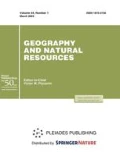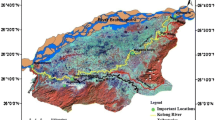Abstract
Presented are the results from studying the current state, modeling and forecasting of the transboundary transport of pollutants with the flow of the rivers within the Selenga river basin. The method for calculating the pollution coefficient was used to assess the degree of pollution of the Selenga river basin on the territories of Mongolia and the Republic of Buryatia (RF) on the linear sections of the river and its tributaries within the boundaries of the adjacent river sections according to data of state monitoring observation in both countries. Results from assessing the impact of economic entities located within the transboundary Selenga river basin on the streams according to the α-indicator of the pollution coefficient and subsequent ranking by four levels of pollution indicate that the catchment and Lake Baikal itself continue to be polluted by insufficiently treated wastewater from industrial enterprises and housing and communal services. Calculations showed that the aquatic ecosystems of the Kyakhtinka (Khiagt), Modonkul’ Selenga rivers in the border zone along the border of Russia and Mongolia in the area of Naushki – Sükhbaatar and Kyakhta ‒ Altanbulag, and in the area of the settlement of Novoselenginsk are most disturbed. On the territory of the Russian part of the basin, the Selenga river downstream, the degree of water pollution is increasing in the areas of industrial centers, such as Gusinoozersk and Ulan-Ude. The average indicator of the pollution coefficient as calculate for the Russian part of the Selenga river basin was higher than that for the Mongolian part, which suggests the conclusion that the degree of pollution by the pollutants under consideration is higher on the Mongolian territory than on the Russian territory.
Similar content being viewed by others
REFERENCES
Votintsev`, K.K., Hydrochemistry of the Rivers Within the Lake Baikal Drainage Basin, Moscow: Izd. AN SSSR, 1965, vol. 8 [in Russian].
Zhambaazhamts, B., Mongol orny uur am’sgal (Climate of Mongolia), S. Sangidansranzhav, Ed., Ulaanbaatar: UKhG, 1989 [in Mongolian].
Forsh, T.B., Concerning the Chemical Composition of Water in the Tributaries of Lake Baikal, Tr. Baikal’sk. Limnol. Stantsii, vol. 1, pp. 1–18 [in Russian].
Dogopik, I.Ya., Concerning the Chemical Composition of Water in Some Tributaries of Lake Baikal, Tr. Baikal’sk. Limnol. Stantsii, 1951, vol. 13, pp. 225–242 [in Russian].
Bochkarev, P.F., Hydrochmistry of the Rivers of Eastern Siberia, Irkutsk: Kn. Izd., 1959 [in Russian].
Sorokovikova, L.M., Popovskaya, G.I., Tomberg, I.V., Sinyukovich, V.N, Kravchenko, O.S., Marinaite, I.I., Bashenkhaeva, N.V., and Khodzher, T.V., The Selenga River Water Quality on the Border With Mongolia at the Beginning of the 21st Century, Russ. Meteorol. Hydrol., 2013, vol. 38, issue 2, pp. 126–133.
Chebykin, E.P., Sorokovikova, L.M., Tomberg, I.V., Vodneva, E.N., Rasskazov, S.V., Kodzher, T.V., and Grachev, M.A., Modern State of Water in the Selenga River on the Territory of Russia as Deduced From Major Components and Trace Elements, Khimiya v Interesakh Ustoichivogo Razvitiya, 2012, vol. 20, no. 5, pp. 613–631 [in Russian].
Brumbaugh, W.G., Tillitt, D.E., May, T.W., Javzan, Ch., and Komov, V.T., Environmental Survey in the Tuul and Orkhon River Basins of North-Central Mongolia, 2010: Metals and Other Elements in Streambed Sediment and Floodplain Soil, Environ. Monit. Assess., 2013, vol. 185, issue 11, pp. 8991–9008.
Erdenebayar, Ya., Quality Monitoring of the Transboundary Waters During 2005–2012, Proc. V Int. Sci. Conf. “The Selenga – A River Without Boundaries (Integrated Governance of Natural Resources in the Lake Baikal Transboudary System)” (July 5‒6, 2012, Ulan-Ude; Ulaanbaatar), Ulan-Ude: Izd. Baikal’skogo Inst. Prirodopol’zovaniya SO RAN, 2012, pp. 196–205 [in Russian].
Kasimov, N.S., Lychagin, M.Yu., Chalov, S.R., Shinkareva, G.L., Pashkina, M.P., Romanchenko, A.O., and Promakhova, E.V., Catchment-Based Analysis of the Flow of Matter in the Selenga-Baikal System, Vest. Mosk. Univ., Ser. 5, Geografiya, 2016, no. 3, pp. 67–81 [in Russian].
Garmaev, E.Zh., The Discharge of the Rivers Within the Lake Baikal Drainage Basin., Ulan-Ude: Izd. Buryat. Univ., 2010 [in Russian].
Sorokovikova, L.M., Tulokhonov, A.K., Sinyukovich, V.N., Popovskaya, G.I., Nikulina, I.G., Tomberg, I.V., Bashenkhaeva, N.V., Maksimenko, S.Yu., Pogodaev, T.V., Il’icheva, E.A., and Nekrasov, A.V., Water Quality in the Selenga Delta, Geogr. Prir. Resur., 2005, no. 1, pp. 73–80 [in Russian].
Batbayar, G., Pfeiffer, M., von Tümpling, W., Kappas, M., and Karthe, D., Chemical Water Quality Gradients in the Mongolian Sub-catchments of the Selenga River Basin, Environ. Monit. Assess., 2017, vol. 189, issue 8, Article Number 420.
Thorslund, J., Jarsjö, J., Wällstedt, T., Mörth, C.M., Lychagin, M.Yu., and Chalov, S.R., Speciation and Hydrological Transport of Metals in Non-acidic River Systems of the Lake Baikal Basin: Field Data and Model Predictions, Reg. Environ. Change, 2017, vol. 17, issue 7, pp. 2007–2021.
Chalov, S., Thorslund, J., Kasimov, N., Aybullatov, D., Ilyicheva, E., Karthe, D., Kositsky, A., Lychagin, M., Nittrouer, J., Pavlov, M., Pietron, J., Shinkareva, G., Tarasov, M., Garmaev, E., Akhtman, Y., Jarsjö, J., The Selenga River Delta: A Geochemical Barrier Protecting Lake Baikal Waters, Reg. Environ. Change, 2017, vol. 17, issue 7, pp. 2039–2053.
Gagarina, O.V., Assessment and Standardization of the Natural Water Quality: Methodological Manual, Izhevsk: Izd. Udmurtskii Univ., 2012 [in Russian].
Belogurov, V.P., Using Generalized Indicators in Assessing the Pollution Level of Water Bodies, in Integral Assessments of the Surface Water Quality, Leningrad: Gidrometeoizdat, 1984, pp. 33–43 [in Russian].
Order of the Federal Agency for Fisheries of January 18, 2019 No. 20 “On Approval of Water Quality Standard Rates for Water Bodies of Fisheries Significance, Including Standard Rates of Maximum Allowable Concentrations of Pollutants in the Waters of Water Bodies of Fisheries Significance. URL: https://www.garant.ru/products/ipo/ prime/doc/2070984/ (Accessed 9.25.2015) [in Russian].
Gomboev, B.O., The Ecological-Geographical Characteristic of the Transboundary Selenga River Basin, Proc. V Int. Sci. Conf. “The Selenga – A River Without Boundaries (Integrated Governance of Natural Resources in the Lake Baikal Transboudary System)” (July 5‒6, 2012, Ulan-Ude; Ulaanbaatar), Ulan-Ude: Izd. Baikal’skogo Inst. Prirodopol’zovaniya SO RAN, 2012, pp. 137–144 [in Russian].
Khakhinov, V.V., Hydrochemical Assessment of the Surface Water Quality of the Selenga River Basin, Proc. V Int. Sci. Conf. “The Selenga – A River Without Boundaries (Integrated Governance of Natural Resources in the Lake Baikal Transboudary System)” (July 5‒6, 2012, Ulan-Ude; Ulaanbaatar), Ulan-Ude: Izd. Baikal’skogo Inst. Prirodopol’zovaniya SO RAN, 2012, pp. 207–213 [in Russian].
State Report “On the Environmental Status and Protection in the Republic of Buryatia in 2011, Ulan-Ude: Min. Prir. Resursov Respubliki Buryatia [in Russian].
Report on State of the Environment of Mongolia 2008‒2010, Ulaanbaatar: Ministry for Nature, Environment and Tourism, 2011.
Zomonova, Erz.M. and Gomboev, B.O., Hotspot Areas of the Selenge River Basin in Mongolia: The Economic and Environmental Aspects, Ekonomika i Predprinimatel’stvo, 2013, no. 12, part 1, pp. 313–318 [in Russian].
Gomboyev, B.O., Simulation of the Pollutants’ Transfer Along the Selenga River on the Territories of Mongolia and Russia, Vodnoe Khozyaistvo Rossii: Problemy, Tekhnologii, Upravlenie, 2014, no. 6, pp. 4–21 [in Russian].
Information Bulletin on the Status of Surface Water Bodies, Waterworks Systems and Facilities on the Territory of the Republic of Buryatia for 2011, Ulan-Ude: Izd. Buryat. Tsentra po Meteorologii i Monitoringu Okruzhayushchei Sredy, 2012 [in Russian].
Zomonova, E.M., The Use and Protection of Water Resources: Management Problems, Problemy Teorii i Praktiki Upravleniya, 2011, no. 8, pp. 108–117 [in Russian].
Funding
This work was done within the framework of a state assignment of Baikal Institute of Nature Management SB RAS.
Author information
Authors and Affiliations
Corresponding authors
Additional information
Translated by V.B.Sochava Institute of Geography SB RAS
Rights and permissions
About this article
Cite this article
Gomboev, B.O., Tsybikova, A.B., Ul’zetueva, I.D. et al. Assessing the Anthropogenically Caused Pollution of Water Bodies Within the Selenga River Basin on the Territory of Mongolia and Russia. Geogr. Nat. Resour. 41, 372–380 (2020). https://doi.org/10.1134/S1875372841040083
Received:
Revised:
Accepted:
Published:
Issue Date:
DOI: https://doi.org/10.1134/S1875372841040083




